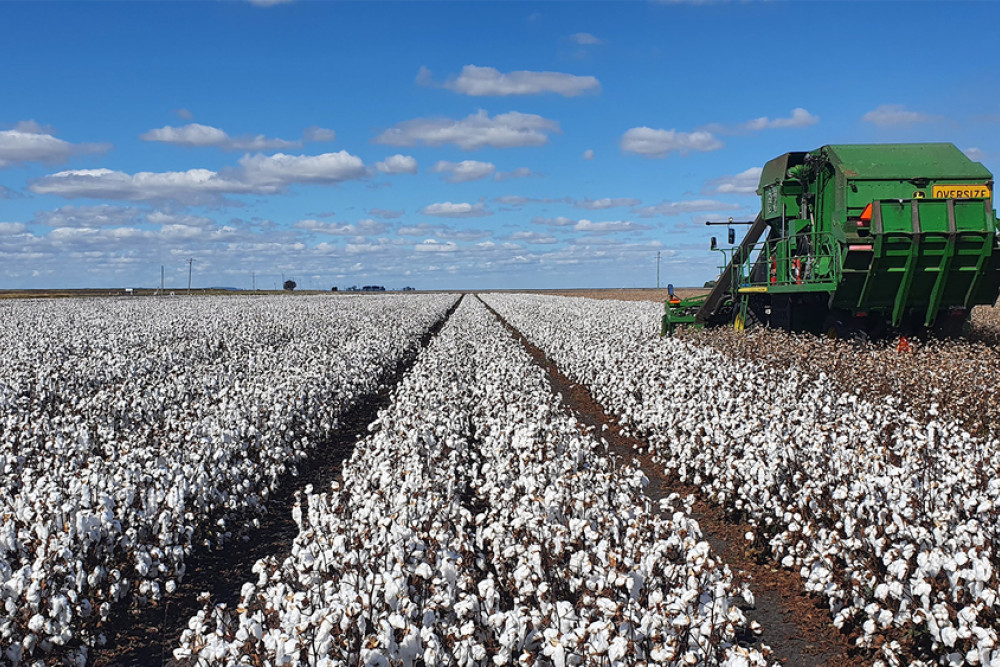Agricultural
4 May, 2023
Cotton Picking underway with positive signs despite challenges
Picking has begun in most of Australia’s cotton growing regions with positive signs emerging that the flooding and farm damage late last year may not have been as devastating as first feared, aided by dryer and warmer conditions since Christmas.

While the impact varied from state to state and region to region, some farmers were forced to scale back their plantings, particularly in the Southern Valleys and Macquarie where farmers couldn’t get on their paddocks to plant and subsequently missed their window of opportunity.
Cotton Australia CEO Adam Kay said with favourable conditions across most of the 65 plus local government areas growing cotton this year, growers are reassessing yield and quality.
“To appreciate where we are now you first have to acknowledge where we were,” he said.
“Last November every inland river catchment was full or flooded from the Queensland border to Victoria and around 100 active warnings were in place.”
One area impacted by the wet weather is the Southern Valleys where defoliation is just starting after late planting.
Wet weather at planting stage resulted in a one-third reduction in crop planted.
In the Macquarie Valley picking has just started north of Warren after farmers reported a 30 per cent crop reduction due to the well-above rain recorded in 2022.
The upside is that quality is expected to be good, and above average temperatures in February and March have provided very good boll filling conditions for crops.
In the Gwydir Valley early dryland is being picked and yielding up to 7 bales per hectare with around double that for irrigated cotton.
The cotton not impacted by spray drift is around the 14 bales per hectare and about 15 per cent is picked at this stage in the Gwydir with 30 per cent picked in the lower Namoi, 5 per cent in the Upper Namoi and picking has just started in Walgett and Bourke with yield predictions difficult, particularly in drift impacted areas.
In the MacIntyre Valley, 44,000 hectares of irrigated cotton and 8,000 hectares of dryland has been planted with 15 per cent picked already and activity hitting full capacity last week.
While the dryland cotton could have used some late rain, the irrigated crop is looking very positive.
While the gins are not yet operational the cotton being delivered is looking to be high quality.
Picking is in full swing in St George, Dirranbandi and Mungindi with the majority of the early crop to be picked over the next two weeks and later crops a month away from picking.
Growers are reporting good yields and quality and while early indications are good, ginners are just starting so there are no results to confirm the optimistic outlook at this stage.
Grower Jonathan Mengel of ‘Bonnington’ at Nangwee says he’s up to the defoliation stage.
“There’s a bit of wind and it’s mostly sunny, so pretty good conditions,” he said.
Darling Downs growers are up to the defoliation stage of the season mostly and a few have started picking the early planted fields.
Due to full storages and full water allocations at the beginning of the season as well as a full soil moisture profile, larger than average areas were planted, around 75 per cent irrigated fields and 25 per cent rain-fed.
Gins are predicting they will start full operation in the second week of May.
Mr Mengel said following last year’s wetter than average totals, he’s got good sub-soil moisture levels.
“For the coming season, we’ve got underground allocation available, with our ring tanks mostly empty.
“We’d like it to stay fine and dry for the next couple of months.
In the Lockyer Valley, 10 growers have planted approximately 1500 hectares of cotton and that’s up from previous years, driven by price, crop rotation practices and growing conditions.
At Maryborough three growers have planted 500 hectares.
In the Central Highlands both gins are operational with the cotton clean but no yield information yet, however early crops are reporting up to 13 bales per hectare irrigated.
A number of growers are still irrigating and will push through until June picking.
Mr Kay said Cotton Australia was forecasting a crop around 5.2 million bales for 2023.
“This will result in around 1.2 million tonnes of fibre and 1.4 million tonnes of cottonseed,” he said.
“Every bale of cotton and every tonne of seed will be sold, given the demand for the Australian grown product.”
The Murray Darling Basin Authority reports that major water storages in the basin are at around 90 per cent capacity meaning the outlook for next season is positive as well.
“It’s good news for local communities because figures from the Australian Bureau of Statistics (ABS) 2021 Agricultural Census revealed that cotton was grown in 65 local government areas with more than 75 per cent of cotton grower business expenses spent locally,” Mr Kay said.


